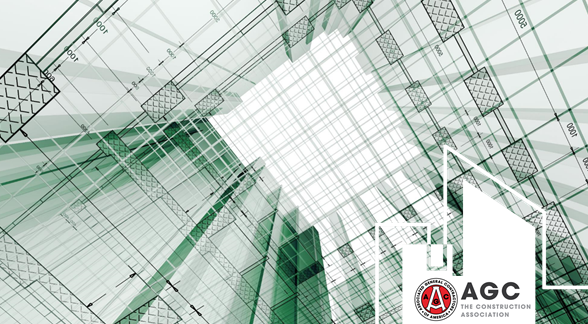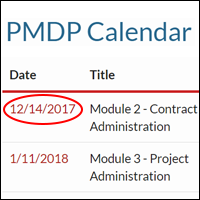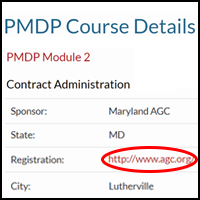Advance Your Career as a Construction Project Manager. If you are an early-career project manager or looking to move into this role, this is a can’t-miss opportunity. Participate in the highly-interactive PMDP courses, specifically designed for the construction industry.

The Project Manager Development Program (PMDP), created by AGC of America, is designed to specifically meet the needs of the construction industry. The curriculum, along with the activities and shared experiences of course participants, provides the necessary skills and knowledge to increase the participant’s ability to work successfully with others to ensure project success.
The 40-hour five-unit program covers the basics of project management and provides tactics and strategies for ensuring project success. Each course listed below consists of 8 hours of instructor-led live and in-seat classroom instruction.
- Unit 1 Introduction to Project Management
- Unit 2 Initiating and Planning Part 1
- Unit 3 Initiating and Planning Part 2
- Unit 4 Executing
- Unit 5 Monitoring and Controlling and Project Closeout
The class will discuss that a successful PM must be competent and efficiently model specific soft and technical skills. Each of these skills are defined and examples provided to highlight the skill’s purpose and its proper implementation during a project. Unit 1 will also provide a high-level overview of construction law, highlighting specific terms, and the PM’s responsibilities. Additionally, there will be an introduction and emphasis on project safety.
Topics and objectives include:
- The five process groups in Project Management
- Discuss the importance of time management and work/life balance
- Project Managers’ role and responsibilities in the construction industry
- The importance of consistent implementation of personnel management policies
- Identify the soft skills critical to the Project Manager role
- Summarize the value of communication and ethics
- Discuss the importance of leadership and teamwork
- Explain why a Project Manager must be an effective problem solver
- Identify the technical skills critical to the Project Manager role
- Explain why the Project Manager must proficiently use computer software
- Identify the need for building codes and permits
- Describe the impact of Construction Law on the Project Manager’s roles and responsibilities
- Define the terms commonly used in Construction Law
- Discuss the importance of project safety and risk
- Identify State and Federal construction industry safety laws
- Identify the four most common types of project delivery systems
- Explain the purpose of an Estimate during project planning
- Explain the difference between quality assurance and quality control
- Describe the Project Manager’s role in documenting progress throughout the project
Unit 2 focuses on the first 2 process groups of Project Management: Initiating and Planning. This unit introduces the Initiation process group of Project Management. The instructor will cover the types of stakeholders involved in a construction project, from initiation to completion. The process of defining the project objectives, creating the Project Charter, and choosing an appropriate project delivery system will be reviewed. This unit also defines the concept of Project Scope. Instructors explore the purpose of the Project Scope and how it impacts the project during the entire project life cycle. The remainder of this unit focuses on the Planning process group of Project Management. This unit covers the elements of a Project Management Plan in detail. Project Managers learn how to develop a schedule for a construction project.
Course objectives include:
- Define the five process groups in Project Management
- Identify the stakeholders participating in a construction project
- Determine the project objectives
- Explain the purpose of the project scope
- Identify the impact of scope creep during a project
- Speculate how environmental and sustainability considerations can impact the project scope
- Discuss the importance of a Project Plan to the success of a construction project
- Discuss the differences between planning and scheduling
- Identify the components of a project schedule using the known timeframe and factors associated with a construction project
- List the documents included in a Project Plan
Unit 3 is a continuation of Unit 2, Initiating and Planning, Part 1. This unit covers determining project cost to include Estimates, Bids and final Budget, in depth. Instructors will teach Project Managers how to identify project resources and develop plans for quality, team acquisition, communication management, identifying and managing risk, project procurement, and stakeholder management.
- Explain the difference between a Budget, an Estimate, and a Bid
- List the steps to create an Estimate in chronological order
- Identify the differences between the components of an Estimate
- List the characteristics of an effective Estimate
- List the documents included in a completed Estimate
- Describe the differences between a contractor and a subcontractor
- Determine overhead costs and factor them into Estimates
- Explain the benefits of implementing Value Engineering
- List the steps to create a Bid in chronological order
- List the documents included in a completed Bid
- List the items developed during the Planning process group of Project Management
- Identify the elements of a Quality Plan for a construction project
- Identify the elements of a Team Acquisition Plan for a construction project
- Identify the elements of a Communication Management Plan for a construction project
- Identify the elements of a Risk Management Plan for a construction project
- Identify the elements of a Project Procurement Plan for a construction project
- Identify the elements of a Stakeholder Management Plan for a construction project
- Identify planning resources used by the Project Manager
Unit Four presents the third process group of Project Management: Executing. This unit introduces contract management in the construction industry. Project Managers learn the steps to creating a contract, reviewing contract documents, and identifying the difference between contractors and subcontractors. This section also addresses how to bill during a project, the reason(s) for contract termination, and the steps to contract termination. Section Two of this unit covers effective implementation of the project.
Course objectives include:
- Discuss contract language related to a construction project
- Identify techniques for negotiating contracts and subcontracts
- Identify the standard documents included in a construction contract
- Explain the process of subcontractor and owner billing
- Discuss the purpose of a mechanic’s lien for security interest
- Identify the circumstances that lead to contract termination
- Describe how to use the schedule as a tool during the Execution process group of Project Management
- Discuss the importance of tracking the Estimate against project costs
- Summarize the steps to acquiring and developing a project team
- Describe how to effectively implement communication plans during the Execution process group of Project Management
- Describe the process for distributing documentation during a project
- Discuss how to implement risk responses to previously identified project risks
- Discuss how to implement responses to newly identified risks during the execution of a project
- Identify the process for purchasing and procurement of project materials
- Explain the importance of proper material handling and storage
- Explain the importance of the Uniform Commercial Code
- Discuss the challenges of selecting equipment for a construction project
- Explain how to process requests for information between stakeholders
- Identify techniques for managing routine and surprise inspections
This unit presents the fourth and fifth process groups of Project Management: Monitoring and Controlling; and Closing. This unit focuses on changes that may occur during the life cycle of a project and how to finalize project processes. This unit emphasizes that the Executing, and Monitoring and Controlling process groups are iterative processes. It also addresses topics such as dispute resolution, how to document changes, the impact of changes on the overall schedule and budget, maintaining quality assurance, and change order management. This final unit focuses on the process of closing out a construction project. The instructors review the process for project closeout to include both administrative closure and contract closure. This unit emphasizes customer satisfaction and reviews the required communication with and documentation for the owner during closeout.
Course objectives include:
- Describe how changes to the project impact the overall project scope and estimate
- Manage changes to the project schedule during a project
- Explain the term “time value of money” as it applies to a construction project
- Identify the process steps for managing/documenting the time and scope changes to a project
- Demonstrate the correct process to manage a change request
- Outline the steps to engaging with building authorities
- Describe the process for addressing identified non-compliant items following testing
- Identify available software options for Construction Management
- Describe the process for documenting project team communications
- Manage project risks that arise during the execution of a project
- Oversee the processing of claims for time and cost
- Describe the importance and the steps of title transfer to the owner
- Identify conflict resolution techniques to monitor disputes
- Outline tips for scheduling an effective meeting
- Describe the process of closing out a project with a client
- Summarize the importance of a positive customer experience throughout the project
- Outline the components involved in owner training prior to closing out a project
- Verify product quality through testing, balancing, and commissioning prior to the completion of the project
- Describe the purpose of As-Built Drawings
- Define the difference between substantial completion and final completion
- Generate and complete the punch list
- Describe the difference between a warranty and liability tail
- Explain the additional closeout requirements for a LEED-Certified project
- Describe the process to manage and mitigate liquidated damages
An AGC Education Learning Tool
To register for classes please follow the following steps below.
PMDP courses are predominately offered by AGC Chapters around the country with both in-person and virtual offerings. Locate upcoming classes through the PMDP Course Calendar
 |
After navigating to the PMDP Course Calendar find an upcoming course and click on the date to view the class details. |
| Register directly with the AGC chapter for your courses. |
 |
If you cannot locate an PMDP course in your location, we recommend contacting your local AGC chapter using the Chapter Finder, and request the course be scheduled in the future.
If you have a large group to train, you can bring the courses in-house to your organization. Click here to see how you can bring AGC’s Project Manager Development Program to your organization.
Click the links below to learn more about each unit.
Unit 1: Introduction to Project Management
Unit 2: Initiating and Planning - Part 1
PMDP is a nationally recognized training standard. Individuals who complete all five PMDP courses will receive an AGC Project Manager Development Program Certificate of Completion.
